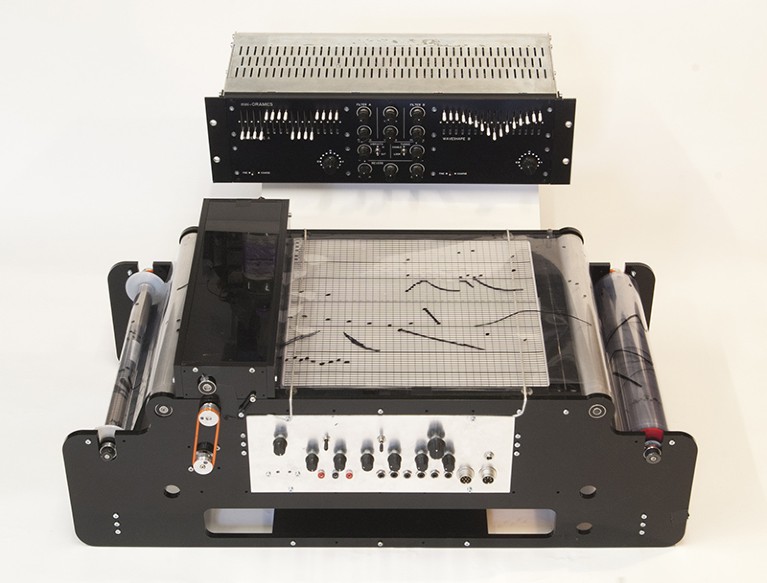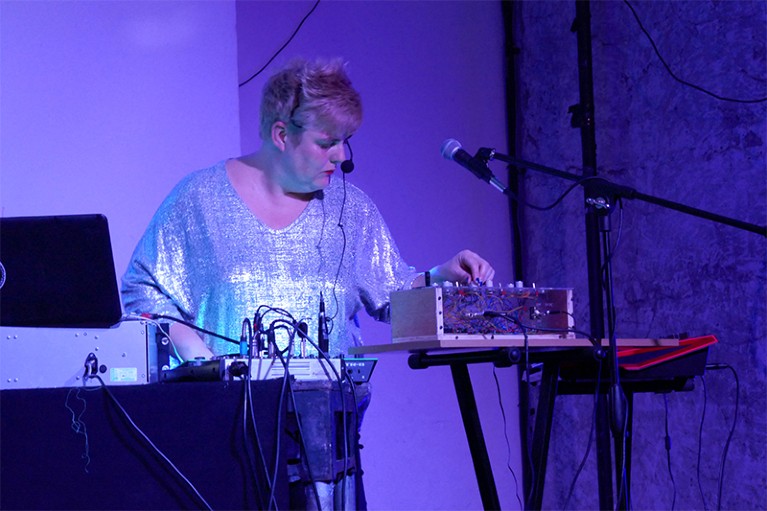
Daphne Oram in her home studio in 1962.Credit: Daily Herald Archive/NSMM/SSPL/Getty
Synth Remix 93 Feet East, London. 8 November 2018; Touring 8–11 November.
The history of electronic music usually centres on the men (including Pierre Schaeffer, Olivier Messiaen, Pierre Boulez, Karlheinz Stockhausen and Edgard Varèse) who developed musique concrète from recorded everyday sounds in Paris in the mid-twentieth century. Yet in those decades, a group of sound engineers — many of them women — were making waves in an old London skating rink.
The BBC Radiophonic Workshop produced effects and theme tunes for the British broadcaster, including iconic sounds for the sci-fi television and radio programmes Doctor Who and The Hitchhiker’s Guide to the Galaxy, using electronic oscillators and tape loops decades before synthesizers were common. That many of its engineers were women was, and still is, a rarity. Last week, two of them, Daphne Oram and Delia Derbyshire, were celebrated anew in Synth Remix, a concert series of live performances and DJ sets touring Britain.
Oram (1925–2003) co-founded the Radiophonic Workshop. She gained experience in mixing electronics and music during the Second World War while working for the BBC on sound balance for radio broadcasts. During Germany’s bombings of London in the Blitz, she switched pre-recorded tracks of orchestral music into broadcasts of live music. That allowed the musicians to flee the city’s grand concert venue, the Albert Hall, without the radio audience knowing.
In the 1950s, Oram became intrigued by the potential of tape recording to transform music by exploding space and time. She was a fan of musique concrète, regularly staying up all night to mix her own tracks. In 1958, after years of badgering the BBC to modernize its music, Oram and her colleague Desmond Briscoe were given a room with some old equipment. Thus began the workshop.
Oram, however, left after just a year. The BBC asked her to take six months off, saying it was concerned that the equipment might have adverse effects on the human body. So she quit.

A mini Oramics machine for drawing sound, created by Tom Richards.Credit: Tom Richards
Oram set up her own home studio in a converted rural oast house in Kent. She continued to compose electronic sounds, and to lecture and write about the nature of vibrations. She launched a field that she called Oramics, using a device that she built for ‘drawing’ sound. The size of a dressing table, it subverted the technology behind the cathode-ray oscilloscope, which converts sound waves into a picture. Lines, squiggles and dots sketched on 35-mm film were scanned and used as indications of pitch, vibrato and timbre. (It was, in effect, an early sequencer — a technology that eventually came along in the 1980s.) In her seminal 1972 book An Individual Note of Music, Sound and Electronics, she wrote of humans as instruments, harbouring “a whole spectrum of resonant frequencies” that are “vibrant with pulsating tension”.
Oram paved the way for Derbyshire (1937–2001), who famously crafted the unearthly ‘sweeps and swoops’ of the Doctor Who theme tune in 1963 (see video, lcourtesy of BBC Studios). Derbyshire told interviewers that her love of abstract sounds came from the air-raid sirens she heard growing up in Coventry during the Blitz, recalling that “the sound of the ‘all clear’” was electronic music. She studied mathematics and music at the University of Cambridge, and took an analytical approach to experimenting with sound. Her notes, now archived at the University of Manchester, are full of mathematical symbols and equations. She jotted down explicit frequencies and used the dots and dashes of Morse code.
Her sketched scores are visual — crescendos of squiggles, rings of organic contours and hatched textures of mass and void. Triangular bursts march across the page like streams from flak guns. Some rounded forms look like the Lissajous patterns (formed from interacting sine waves) that she must have seen on oscilloscope displays. Her notes are also littered with evocative words: hum, beat, splash, shimmer.
This Radiophonic legacy was the launching point for the concerts, performed by musician Jo Thomas and artist Olivia Louvel. At the first performance at 93 Feet East, a concrete venue in east London, each deftly controlled networks of tabletop electronics. These sent tsunamis of sound waves shuddering through the audience’s chests, and lofted clouds of siren vocals around our heads. The compositions were compelling, richly textured and darkly powerful.

Musician Jo Thomas uses a self-built synthesizer on stage.Credit: Dom McIntyre
Electronic music integrates science with art, and Thomas has roamed far into that liminal space. In 2012, her Crystal Sounds of a Synchrotron — based on blips and beeps from the Diamond Light Source particle accelerator near Didcot, UK — won an international award for digital music and sound art from Austrian arts body Ars Electronica. Here, her three-part work Nature’s Numbers nods to Derbyshire and Oram using a bank of self-built electronic components, conventional synthesizers and computers augmented with tones of her own voice. Thomas immersed herself in Derbyshire’s archives for Synth Remix.
‘Time Lament’, the first part of Thomas’s performance, combines high, plaintive vocals over a heartbeat reminiscent of spinning tape loops. Inspirations include Derbyshire’s love of seventeenth-century composer Henry Purcell (and his aria ‘Dido’s Lament’) and effects from The Hitchhiker’s Guide to the Galaxy. In ‘Echoes of the Earth’, sounds like showers of rain punctuate the eery silence of a cavern, as a homage to Derbyshire’s vocal experimentations. ‘Cellophane Resonance’ is a playful collage of sci-fi sound effects. Here, Thomas exploits a compact reproduction of an Oramics machine, generating sounds from scribbles on what look like rolls of transparent film from an overhead projector.
Louvel’s multimedia suite Data Regina liberates the voice of another woman from the past. Tudor monarch Mary, Queen of Scots — ultimately executed by her cousin, Elizabeth I of England — was a prolific writer and poet. Yet few know her works. Louvel’s voice, computer music and a video backdrop of avatars that look like chess pieces transmit the story of the tortured queen. The result is a soaring, gut-wrenching opera.
These intuitive and democratic takes on compositions by Oram and Derbyshire reverberate today. You don’t need a bank of high-powered electronics to pick out a beat or strike a chord. Go on, grab your laptop, switch on an app and play with sound. This, in essence, is what they did.

 Pioneers of sound
Pioneers of sound
 The art of engineering: 9 Evenings revisited
The art of engineering: 9 Evenings revisited
 Q&A: Björk, Digital diva
Q&A: Björk, Digital diva








